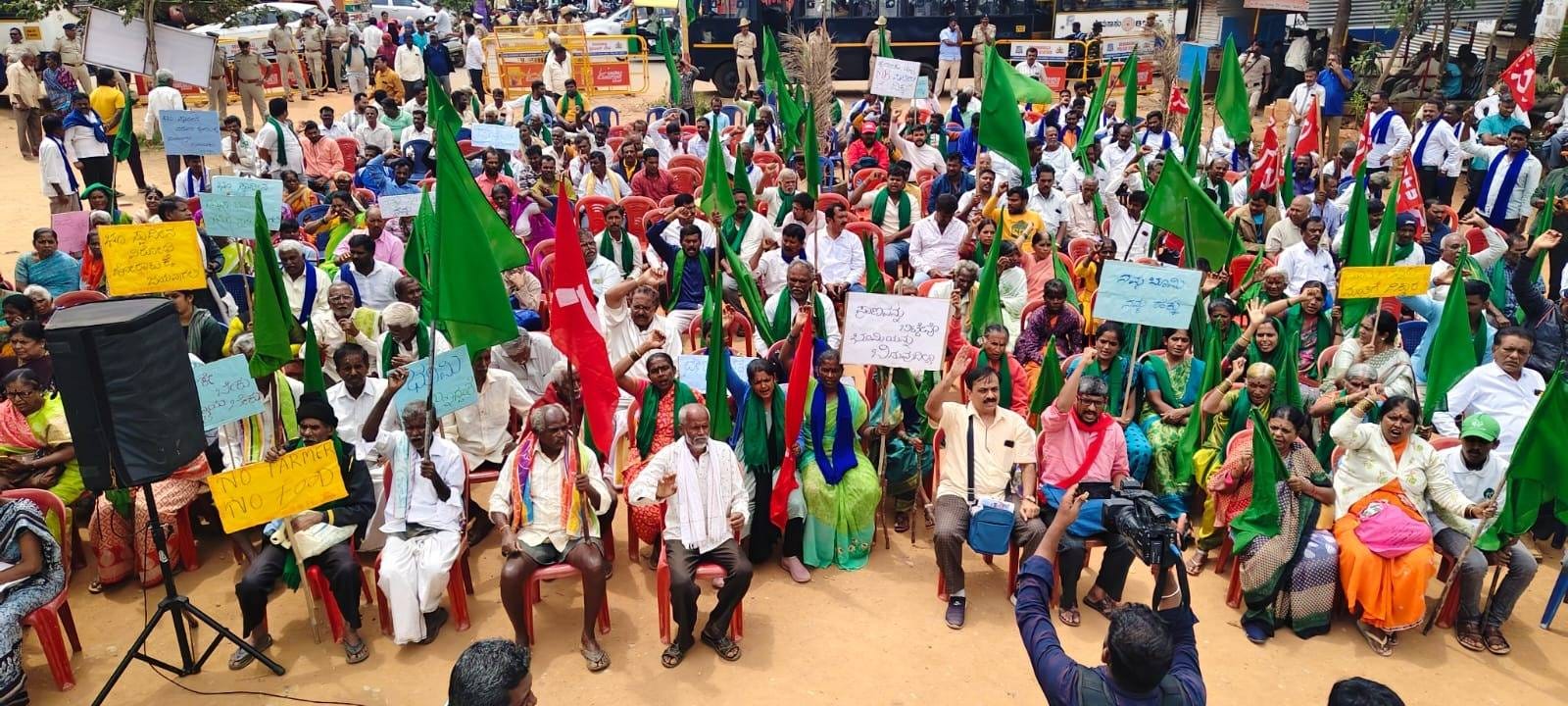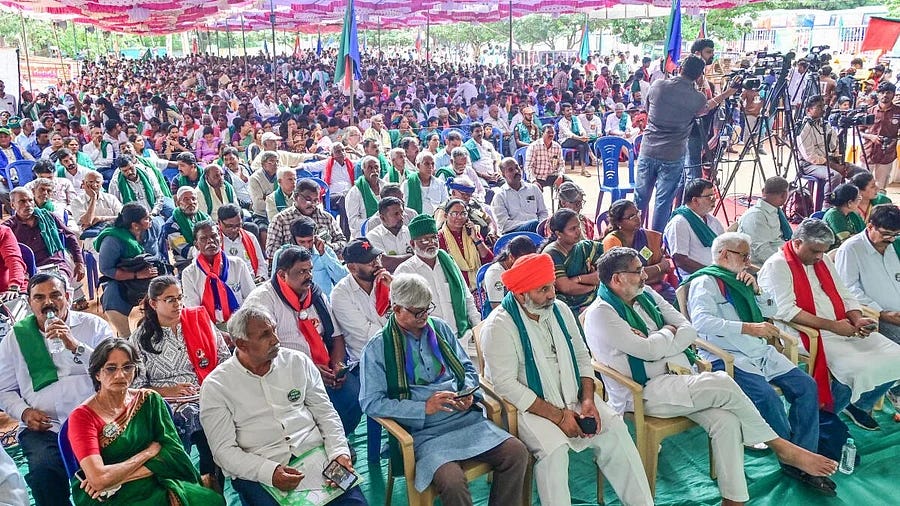The Saga of Peasant Resistance
How Farmers Defeated the Land Grab by India’s Karnataka State

On the 1,198th consecutive day of protest, farmers in Karnataka declared victory on 15 July, forcing the southwestern Indian state’s government to retreat from the plan to grab 1,777 acres of fertile, multi-cropped farmland across 13 villages.
Meeting their representatives on Tuesday at Vidhana Soudha—the seat of the legislature in the state capital, Bangalore—Chief Minister (CM) Siddaramaiah announced the scrapping of land acquisition notices, recognizing the farmers’ struggle against the land grab as “historic”.
He acknowledged that “writers, artists, communist party, people’s movements,” and the historically oppressed Dalit castes had all struggled alongside the resisting farmers, whose leaders emerged from the conference hall, triumphantly whirling their green neck scarves overhead.
Meanwhile, scores of notified farmers were awaiting them in anticipation at the Gandhi Bhavan, just over two kilometers from the Vidhana Soudha.
Cheering their leaders as they arrived, the farmers welcomed T. Yashavantha, general secretary of the farmers’ union, Karnataka Prantha Raitha Sangha (KPRS), with slogans, drum beats and dancing as he joined them with a raised fist.
Yashavantha opened his address to the post-victory meeting at the Gandhi Bhavan by paying tribute to the late G.C. Bayya Reddy, the former state president of KPRS, who, until his death early this year, had led the movement since its start in April 2022.
Earlier in January that year, the state government, then run by the far-right-BJP, had issued preliminary land acquisition notices to the farmers of Channarayapatna Hobli (a cluster of villages grouped for revenue administration) in Devanahalli Taluk (sub-division under a district).
The government insisted on this 1,777 acres of farmland for the development of defense and aerospace industries. But most of the 6,000 acres it had already acquired for the purpose over the last decade lie vacant, Yashavantha points out.
Located on the northeastern outskirts of Bangalore city, close to its international airport, this is prime land, being parceled out to real estate interests, he alleged.
When the government issued the preliminary notification in 2022 for the acquisition of more farmland from farmers who had already lost portions of their plot in the earlier acquisitions, 80% immediately refused. The refusal rate reached 95% as the protests intensified.
The Land Acquisition Act 2013 requires at least 80% consent for acquisition for projects involving the private sector. Bypassing this consent requirement, the government issued these notices under the “draconian” Karnataka Industrial Areas Development (KIAD) Act, 1966, Yashavantha explained.
mers unite under the Anti-Land Acquisition Struggle Committee
Determined to resist, farmers of the hobli came together to form the Channarayapatna Anti-Land Acquisition Struggle Committee.
The prolonged resistance began that April with a demonstration outside the sub-divisional revenue office in the hobli. Taking turns in relay, the farmers maintained a daily presence there until the victory on Tuesday, when they concluded the demonstration with a celebration following a victory procession.
Honoring all those who “suffered police assaults, arrests, and cases” during these over three and a half years of struggle, Yashavantha recalled in his victory speech, “Even after two surgeries, Pramod, a young farmer from Pollanhalli, has not been able to recover his sight.”
He lost his eye on Independence Day, 24 August 2024, to the batons of police who charged at the farmers when they took to the streets in one of their first major protests of this struggle.
To prevent Reddy from attending this protest, the police arrested him from his home that morning and held him in preventive detention all day, in the dust, while he was suffering from lung disease in his old age, Yashavantha recalled.
Undeterred, Reddy had remained active in this struggle to the very end of his life, even as he breathed through a portable oxygen concentrator he carried around with him to work in his last months. In late December 2024, he had his last meeting with Siddaramaiah.
Condemning the forced acquisition as an opposition leader during the then-BJP government, Siddaramaiah became the CM, winning the election with the farmers’ support in May 2023, promising to scrap the land acquisition notification. However, his government continued to pursue the notified land, while handing out a portion of the already acquired vacant land to a real estate giant, Brigade.
In his meeting with Reddy and other farmer leaders late December 2024, Siddaramaiah had sought time till after Sankranti—an agrarian celebration of harvest in mid-January. The meeting did not take place. Reddy breathed last on 4 January.
Government escalates acquisition process after leader’s death.
“After his death, the government became aggressive.” In February, two of the 12 villages were served with final notices, which effectively transfer ownership of the land to the Karnataka Industrial Areas Development Board (KIADB), Yashvantha told Peoples Dispatch. “In April, they sent final notices to 8 more villages. They mistook Comrade Bayya Reddy’s death to mean the end of resistance. They were wrong.”
On May 20, the government held a convention to mark two years of its rule, enumerating its “accomplishments” and “fulfilled promises”.
A parallel People’s Demand Convention that day challenged the credibility of the pro-poor talk by the Congress government, accusing it of continuing all the actions of the previous BJP government to intensify the exploitation of workers and the dispossession of peasantry.
It was organized in Gandhi Bhavan by the Samyuktha Horata Karnataka (SHM). Led by Reddy until his death, the SHM is a united front of about 40 groups, including over half a dozen farmers’ unions in Karnataka, alongside trade unions, women’s organizations, Dalit organizations, and other progressive activists.
In his inaugural address to their convention on May 20, the convenor of the Channarayapatna Anti-Land Acquisition Struggle Committee had lamented that their voices were no longer being heard in the corridors of power after Reddy’s death.

People’s faith in resistance was at stake
The stakes were high. “If the Channarayapatna farmers lose this battle even after remaining steadfast in their protest for over 1,000 days, people might lose their faith in the power of struggle and resistance. That would leave us with no hope in the country’s future,” Yashavantha explained. “So the convention resolved that this resistance cannot be allowed to fail.”
In the second week of June, SHK and the Channarayapatna Anti-Land Acquisition Committee held a joint assembly in Devanahalli town, issuing the call Devanahalli Chalo-Jail Bharo! (March to Devanahalli—Fill the Jails!) on 25 June.
That day, alongside the SHM leaders, nearly 3,000 farmers, mobilized from across Karnataka, joined the Channarayapatna farmers to protest outside the Devanahalli Taluk office. Public intellectuals, Kannada-language writers, artists—including popular regional film stars—also flocked to the demonstration to show their support for this struggle.
Later that evening, as the size of the demonstration began to thin, police dispersed the protest, using force to drag the resisting leaders off the ground and hurl them into buses as they angrily sloganeered against Siddaramaiah and his government.
They had already resolved in the joint assembly earlier that they would refuse to seek bail and court imprisonment if arrested. However, they were released post-midnight after the CM sought to de-escalate by inviting the leaders of SHM and Channarayapatna’s struggle committee for a meeting on 4 July.
Pressure on the government continued to mount in the meantime. Protests condemning the police action were organized in all 31 districts of the state on 26 July by the Communist Party of India—Marxist (CPIM)—of whose Karnataka state secretariat, Bayya Reddy was a member.
By 27 July, the movement had regrouped for the protests in Bangalore’s Freedom Park to hold pressure on the government until the meeting.
Solidarity by the nationwide farmers’ movement
Leaders of the national Samyukt Kisan Morcha (SKM)—an umbrella of hundreds of farmers’ organizations that had led the historic struggle to defeat the central government’s pro-corporate amendments to farm laws in 2020—also arrived in Bangalore by 3 July.
Reassuring their support in their address to the protest, they threatened the government with a nationwide mobilization in solidarity with the Channarayapatna farmers if the acquisition notices served to them are not scrapped.
Under the enormous pressure, Siddaramaiah, in his meeting with the farmer leaders on 4 July, sought 10 days to overcome the legal hurdles faced in stopping the acquisition process for which the final notices had already been served.
“Come to me—I will personally draft the legal advice needed to remove all such hurdles, so that you can denotify as early as tomorrow,” Gopala Gowda, a distinguished judge retired from the Supreme Court, offered the CM in his address to the protest that day.
Real estate agents and moneylenders counter-mobilize
“These 10 days have been sought not to overcome the legal hurdles as claimed by the CM, but to give time for their real estate agents” to make their last ditch attempt to break the unity of farmers, Yashavantha had warned.
Sure enough, a counter-demonstration with a few dozen people was orchestrated at Freedom Park shortly after the movement shifted its focus to the 13 notified villages, aiming to hold the fort at ground zero during the final, critical days of the struggle.
The leaders of this counter-demonstration then held a conference at Bangalore’s Press Club, claiming to represent farmers who were willing to hand over their lands, but at a higher compensation rate.
Yashavantha identified them as local Congress party leaders, led by the former Zilla Panchayat (District Village Council) member Lakshmi Narayana from Basapura village. Far from being leaders of farmers, he said they are real estate sharks preying on peasants by luring them into ceding their lands to the government, only to usurp their compensation amounts.
Anatomy of dispossession
“Industrial development is only a cover for KIADB’s real function, which is to serve the real estate business,” he explained.
“It has cultivated a coterie of real estate brokers, who are provided with advance information about what lands will be targeted with acquisition notifications,” so that they can maneuver into position, ready to target the most vulnerable of the farmers once they are notified.
Their victims, usually small-plot owners, are often from the Dalit caste. They lack the social connections and the economic resources to bribe officials and offer commissions to middlemen to secure the nearly two dozen documents required to claim compensation in the event that their land, mostly won through land reforms, is grabbed by the state.
While in the “grip of fear” on seeing the notification, they are approached by real estate agents as moneylenders, offering them five to ten lakhs as a loan to get the paperwork completed in time for compensation. As a guarantee for this loan, these small farmers, with no other property, are compelled to mortgage their land.
The terms of their loans require farmers to repay double the amount once they secure compensation. “This usually takes only a year or two when there is no resistance. So the moneylenders get back their money with a hundred percent interest in less than couple of years.”
However, when the resistance against the land acquisition in Channarayapatna reached the verge of victory, the moneylenders’ interest margin was threatened. Relieved from the threat of land acquisition, the farmers could repay the loan before accumulating interest by selling a small fraction of their land.
So the moneylenders-cum-real estate brokers unleashed a misinformation campaign. A rumor was spread in the notified villages claiming that if the land acquisition fails, the government would declare them “green belt”, which would prohibit any sale of land, leaving the farmers unable to repay their loans.
With these false claims, the moneylenders demanded the indebted farmers either sell land to them before it is classified as “green belt”, or join them in the counter-demonstration demanding that their land be acquired for a higher compensation.
In reality, though, these villages already fall under the “green belt”, which only means that the area is agricultural. It carries no prohibition against selling.
The last mile before victory
The SHK and the anti-land acquisition committee of Channarayapatna went village to village, raising awareness about these facts, reassuring legal and other forms of support to farmers who had fallen victim to the moneylenders’ real estate chicanery.
“We succeeded,” he said. The real estate agents were able to barely mobilize fifty farmers for their counter-demonstration, against the 700-odd farmers that had earlier held ground in Freedom Park across the days and nights between 27 June and 4 July.
“The government’s decision on July 15 will not determine whether or not the farmers will prevail. We will always prevail on our land,” Naveen Kumar, finance secretary of KPRS, told reporters on 12 July. Warning Siddaramaiah “to tread carefully”, he added that the CM’s decision that day “will determine whether or not his government will survive.”
On 14 July, representatives of farmers from all 13 villages gathered outside Channarayapatna’s revenue sub-office—the site of the original protest—for an oath-taking ceremony.
Reaffirming their unity unbroken by threats and monetary inducements, the farmers, with their hands over their hearts, declared in chorus: “We reaffirm our vow before the leaders of Karnataka’s people’s movements that even under threat to our lives, we will not surrender our soil.”
A decisive struggle for peoples’ movements
In his victory speech at Gandhi Bhavan on 15 July, after the CM scrapped the land acquisition notices, “Bayya Reddy will rest in peace today,” Yashvantha said. “Even on his deathbed, he was murmuring about Channarayapatna’s struggle before passing away,” he added, eliciting slogans from the farmers for Reddy’s immortality.
Gauging the Channarayapatna farmers’ struggle as a decisive battle in Karnataka, “Reddy often used to refer to this struggle as a trial by fire that would determine whether the popular movements in Karnataka would win or lose,” KPRS joint secretary member Prabha Belavangala recalled. “Today we have won this trial, and declare that the popular movements remain a force to reconcile with.”
Several other villages around Bangalore are under the thumb of land acquisition notices. “Many had resigned to fate on the assumption that the notices under the draconian KIAD Act cannot be resisted. But this victory of the Channarayapatna farmers has given them confidence,” Yashavantha told Peoples Dispatch. “They are now contacting us for support, declaring their will to resist.”




